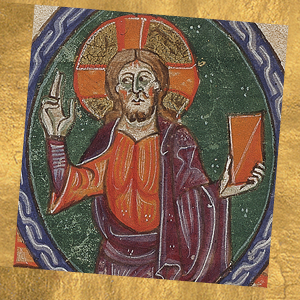St. Valentin, Martyr on the via Flaminia

The Roman Martyrology lists not one, but two Valentines, for February 14th. The first reads thus: "On February 14th, on the Via Flaminia in Rome, St Valentine, priest and martyr, after performing various healing miracles, and known for his culture, was killed by decapitation under Claudius Caesar." The second one states: "On February 14th, in Terni, after being severely beaten, St Valentine was imprisoned and since they (his captors) were unable to overcome his resistance, they secretly dragged him out of prison at midnight and beheaded him on the orders of Placidus, the prefect of Rome".
The Roman priest
The story of Valentine, the Roman priest, dates back to around AD270, during the persecutions of the Emperor Claudius Gothicus. Valentine was well known for his sanctity and the Emperor, who was intrigued by his fame, invited him to the palace. He offered Valentine his friendship and said he should adore the gods. But Valentino stated courageously and firmly that it was a waste of time worshipping the gods since Jesus Christ had brought the only true hope and the promise of a better world. The Emperor was impressed by Valentine’s faith and entrusted him to a Roman nobleman named Asterius, whom he ordered to convert Valentine using "mellifluous arguments". Asterius had a daughter who had been blind since the age of two. Valentino prayed over her and the girl regained her sight. Faced with this miracle, Asterius converted to Christianity along with his whole family. When he heard about their conversion, the Emperor Claudius condemned Valentine to be beheaded. The execution took place on the Via Flaminia in Rome. He was buried nearby and soon a church was built there in his honor.
The Bishop of Terni
The story regarding the Bishop of Terni takes place about seventy years later: Valentine was invited to Rome by the rhetorician and philosopher Crato, a teacher of Greek and Latin. He had a son named Chaeremon who suffered from a physical deformity that forced him to keep his head between his knees. No doctor had managed to heal him. Crato promised Valentine half of his possessions if he healed his son. But during a long night-time conversation, Valentine explained that it would not be his useless wealth that would heal the boy, but his faith in the one true God. Valentine then prayed over the boy and he regained his health. Moved by this miracle, Crato and his whole family were baptized by the bishop, together with three Greek students, Proculus, Ephebus and Apollonius. Abbondius, another student and son of the Prefect of Rome, Furious Placidus, also embraced Christianity. We know that Placidus held office between 346-347AD, so this is the historical date we associate with Valentine's martyrdom. Placidus was devastated by the conversion of his son. He had Valentine arrested and decapitated on the Via Flaminia in Rome. The execution was performed at night to avoid the reaction of the now numerous Christian component of the city. After a brief burial on the site of his martyrdom, Proculus, Ephebus and Apollonius carried the body of the martyr to Terni and buried him just outside the city. But in Terni, the Consul Lucentius, arrested all three of them and before the populace could free them, had them beheaded as well. When they found out about the execution, the people buried the new martyrs together with Valentine in his tomb.
Patron saint of lovers
There are too many connections between the stories of the Valentine of Rome and the Valentine of Terni, including their places of martyrdom and burial, for us not to think they are one and the same person. Both give heroic testimonies of faith, both perform a miraculous healing that causes conversions, and both are martyred by beheading on the Via Flaminia in Rome. It was the Benedictine Order that maintained the church of St Valentine in Terni during the Middle Ages and that spread the cult of Valentine's Day in their monasteries in France and England. The tradition of his being patron saint of lovers finds its origin in an ancient English text by Geoffrey Chaucer, according to whom birds start mating on Valentine's Day. In mid-February, in fact, nature begins to awaken from its winter lethargy, so Saint Valentine has become the saint who announces the coming spring – which is why he is sometimes represented holding the sun in his hand.







